Alaska leads the nation in homes without plumbing, which shouldn’t be a shock as the harsh weather conditions make traditional plumbing and septics very, very cranky. Alaskans know that running water = headaches, and this has been especially true this winter!
I thought this would be a good time to explain our unique plumbing situation! (BTW, I won’t be offended if no one reads this, but I’ve been wanting to document our wonky plumbing system for awhile).
When we purchased our cabin in the summer of 2019, it was considered dry, meaning it didn’t have plumbing or running water, which translates to no traditional shower, sink and toilet, and definitely none of those modern-day amenities, like a dishwasher or washer/dryer.
However, we converted our cabin from “dry” to “moist” starting in 2020. Before you get too excited, we still do not have a toilet and instead rely on our beloved outhouse.

Upgrading our cabin water system was a classic case of NOTHING IN ALASKA IS EASY OR SIMPLE.
Let’s start with the basics. A previous owner of our cabin had the well dug in 2007, and it’s 215 feet deep. The previous owners said they hardly ever used it, and felt it was unreliable. Once we investigated it, we found it was indeed reliable!

We felt it wasn’t enough to have to just have the well spigot outside our cabin to fill containers and such. Besides the working well, the cabin came outfitted with the makings for a kitchen sink and shower, so we thought, let’s connect the dots to give us on-demand running water inside the cabin.
Options for any plumber/electrician/construction are limited in our area, but we hired a guy. First step was building an insulated structure around our well spigot and install a pressure tank and hot water heater.

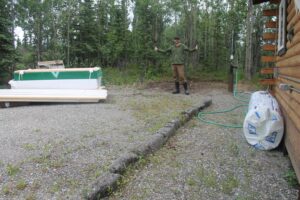




Since we hired someone to build, we opted to make use of hired help and upgrade it into a well house/shed.

The well house would not only house the water system, but would be heated and serve as warm storage for food, paint and other supplies.

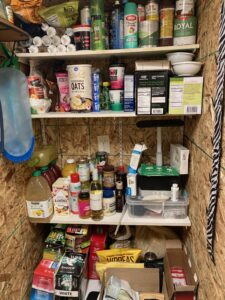
On the other side of the well house would be an unheated shed, which holds our freezer, tools and all the gear.



Next up for our water system was piping the water into the cabin. The position of the well was not super conducive for convenience. It was about 10 feet away from the cabin at an odd angle. Many Alaska homes have their pipes insulated in the ground and come up from underneath the cabin. But that was a bit difficult for our already-built cabin, so our guy piped in from above ground. It’s certainly “Alaskana,” AKA pieced together, complicated construction that is nonsensical and prompts head-scratching. But it works! And the reason they are so high up: so moose can still pass through without any obstacles.
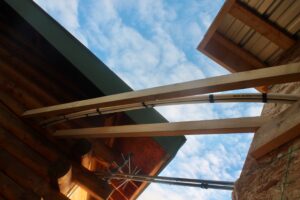

The pipes come into the cabin and run exposed along the log walls and behind the kitchen cabinets. Voila! We have a sink and shower with on-demand running water!



With that being said, there have been a multitude of issues since everything was installed in October 2020.
First up, our guy was not exactly an electrician (which he fully admitted), and there was some issue with the pressure switch. So for the first 11 months of having water, the pressure tank had to be manually switched on and off. If not, the motor capacitor would catch on fire, which it did twice (thankfully we caught it both times).

It might seem like flipping the pressure tank switch on and off is no problem, except that said switch was outside the cabin & well house, you know, where it can get -35 and such. We would rotate who went outside to wait and watch the pressure tank fill and make sure the capacitor wouldn’t catch on fire. This process usually took 10 minutes, which felt like 10 hours when it was below 0. The best part is when someone was showering, there had to be a person outside watching the tank because shower person might run out of pressure (even though it’s a 20-gallon tank, and we definitely didn’t use 20 gallons … just another plumbing mystery). Super fun task, I assure you.
Anyway, after doing this for a full winter and asking multiple friends “who know electrician stuff,” we finally found a very expensive—and more importantly, very real—electrician to move the pressure switch and add some juice to our circuit box. Voila! Pressure tank now automatically fills and turns off capacitor itself.

Next discovery was that even though the well house is insulated and pretty well built, there were some cold spots. Like the floor and the door. Justin has done everything he can to add insulation, including shimmying under the well house.


Figuring out the correct heating system—without tripping breakers—was another part of the equation. We lost track of how many water filters and pipe fittings have frozen and shattered because the well house temperature fell too low and we didn’t catch it happening. This electric panel heater and a fan circulating the heat seems to be the best combo, but it took some serious trial and error.

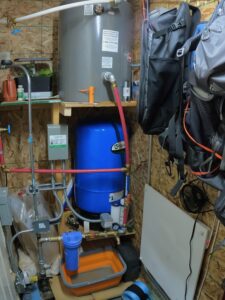
One last—albeit minor—issue is that we have hard water in these parts, and aren’t about to install a water softener. So we have a lot of calcium buildup and have had to replace corroded pieces of the water heater because of that!

The point is, we have running water INSIDE our cabin! Our grey water drains are not insulated, so we still use a bucket system in the winter to wash dishes and shower (yes, we shower in a bucket), but I’ll say it again: we have running water INSIDE our cabin! Huge upgrade in life!


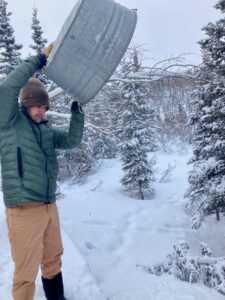
So that is our Alaska-complicated plumbing system at our cabin in a nutshell! (If you’re curious about the full story of our pioneer living before we upgraded our plumbing, I previously did a 3-part blog series about life without running water.)
We don’t have a well at the yurt, and will probably never dig one, but we will have some kind of Alaska-complicated plumbing system there … stay tuned for that.
As for the burning question on everyone’s mind if we’ll ever install a traditional flush toilet with a septic system. Nope, probably never. Having a septic creates even more headaches. We still pee in the woods in unison like the neighborhood moose, lynx and snowshoe hares, and use our beloved outhouse for #2. I promise you, if you’ve never had the frigid air kiss your bare butt cheeks or knocked down a poopcicle (yes, that’s a stalagmite made of you know what) within in your outhouse toilet, you have not lived a full life. Because the rewards of an unexpected aurora and wildlife sighting is worth all that hassle.
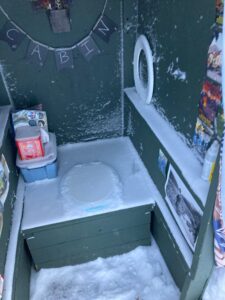
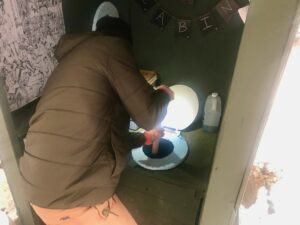
Just another day in Alaska life! Justin is knocking down a tower of poop.







LOL leave it to Justin to be the poopsicle-knocker-downer!
Glad y’all have some water in the cabin now! 🙂 VERY EXCITING!
I’ve been to your cabin, seen how it works and heard you explain how this works to me but, seeing pictures and reading how it all works really clarified things for me! Speaking of pictures what is the blurry furry looking object inside your cabin below the camp sign at the table!?
Good catch Jamie! This picture is from the late summer of 2020, when we were working for Leave No Trace. We created a video about how to stay safe in bear country, so we borrowed that bear pelt as one of our props!